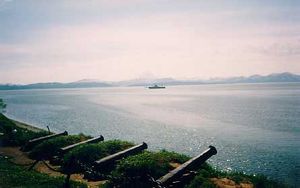Siege of Petropavlovsk
| Siege of Petropavlovsk | |||||||
|---|---|---|---|---|---|---|---|
| Part of the Crimean War | |||||||
 Cannons which were used to defend Petropavlovsk in 1854. |
|||||||
|
|||||||
| Belligerents | |||||||
|
|
|
||||||
| Commanders and leaders | |||||||
|
|
|
||||||
| Strength | |||||||
| ca. 1,700 men 200 cannons 6 warships: |
1,013 men, excluding officers 67 cannons warships: frigate Aurora (44) transport Dwina (12) |
||||||
| Casualties and losses | |||||||
|
Total casualties for all operations = 209 |
37 dead 78 wounded 2 ships: cargo ship Anadyr transport Sitka (10) |
||||||
The "Siege" of Petropavlovsk was a military operation in the Pacific Theatre of the Crimean War. The Russian casualties are estimated at 115 soldiers and sailors killed and seriously wounded, whilst the British suffered 105 casualties and the French 104.
The primary concern of the Anglo-French allies was that cruisers of the Russian Siberian flotilla would operate against British (and French) trade in the area. The British force on the station was under Rear-Admiral David Price (newly promoted after serving as post captain for 39 years) and the French under Rear-Admiral Auguste Febvrier-Despointes. On 9 May 1854 the bulk of the British and French squadrons were at Callao, Peru when they received orders to operate against the Russian cruisers in the Pacific. There were three potential bases for the Russians: Sitka in Russian America (modern Alaska), Okhotsk on the Sea of Okhtosk, and the largest Russian settlement on the Pacific Coast, Petropavlovsk on the Kamtchatka Peninsula. Given the importance of allied trade with California, two British frigates (Trincomalee and Amphritite) and a French corvette (Artemise) were detached to cruise off that coast and defend the California trade. The remaining vessels (British frigates President and Pique, the British steamer Virago, the French frigate Forte, corvette Eurydice and aviso Obligado) set out to hunt down the Russian ships in the Pacific. These six ships were crew by roughly 1,700 men and mounted 200 guns.
The allied squadron concentrated at Honolulu and on 25 July 1854 set out to hunt down the Russian ships. Their first objective was Sikta, which was taken easily but no Russian warships were found. They then set sail for Petropavlovsk.
Putyatin decided he could not meet the allied forces on the open sea, and could not raid allied trade. He had with him only the frigate Aurora, 44 and Dvina, 10. He decided to concentrate all his available forces at Petropavlovsk, using the Dvina to transfer the Okhotsk garrison to Petropavlovsk. His only other vessel on the station was the frigate Pallada, 52 guns at Imperial Harbour on the river Amur. Her captain lightened her by offloading all her guns and took her as far upriver as he could to hide from the allies. The winter would destroy the frigate, as the frozen river crushed the ship's hull.
...
Wikipedia
